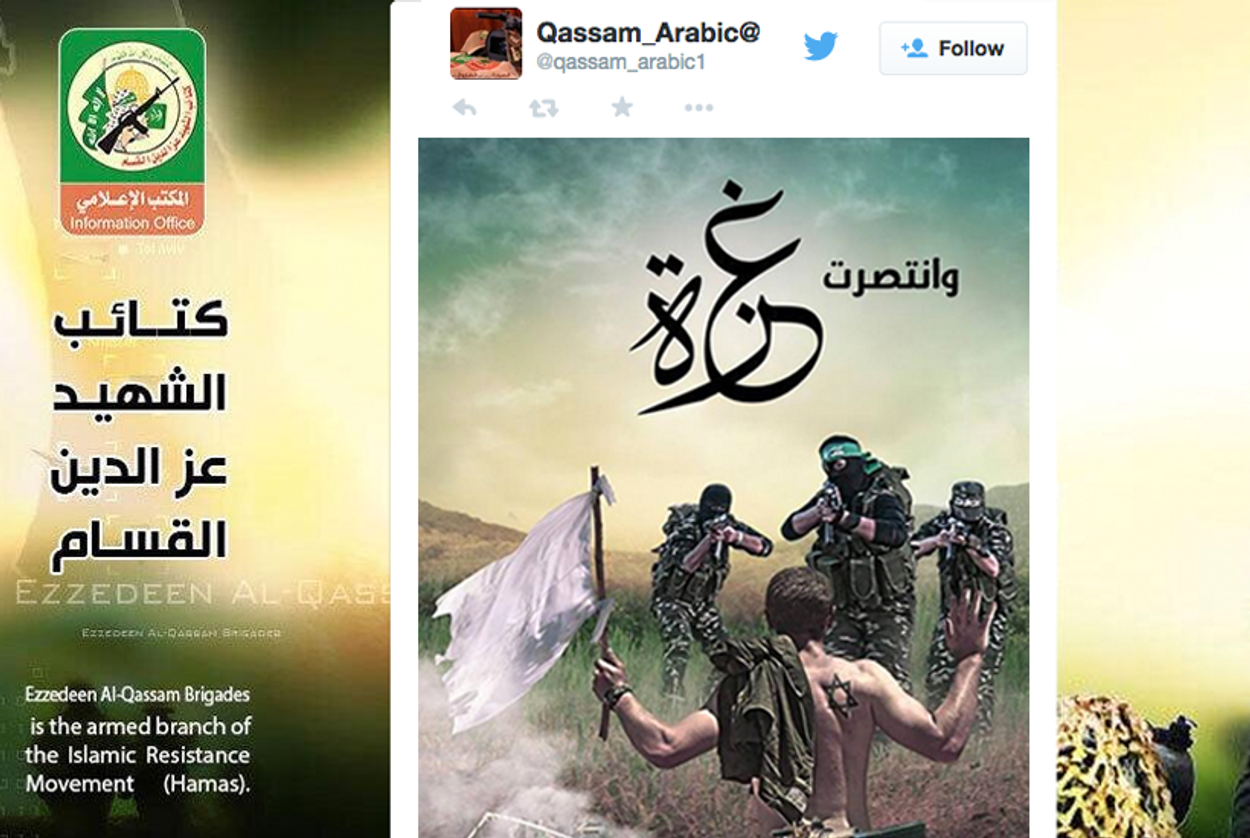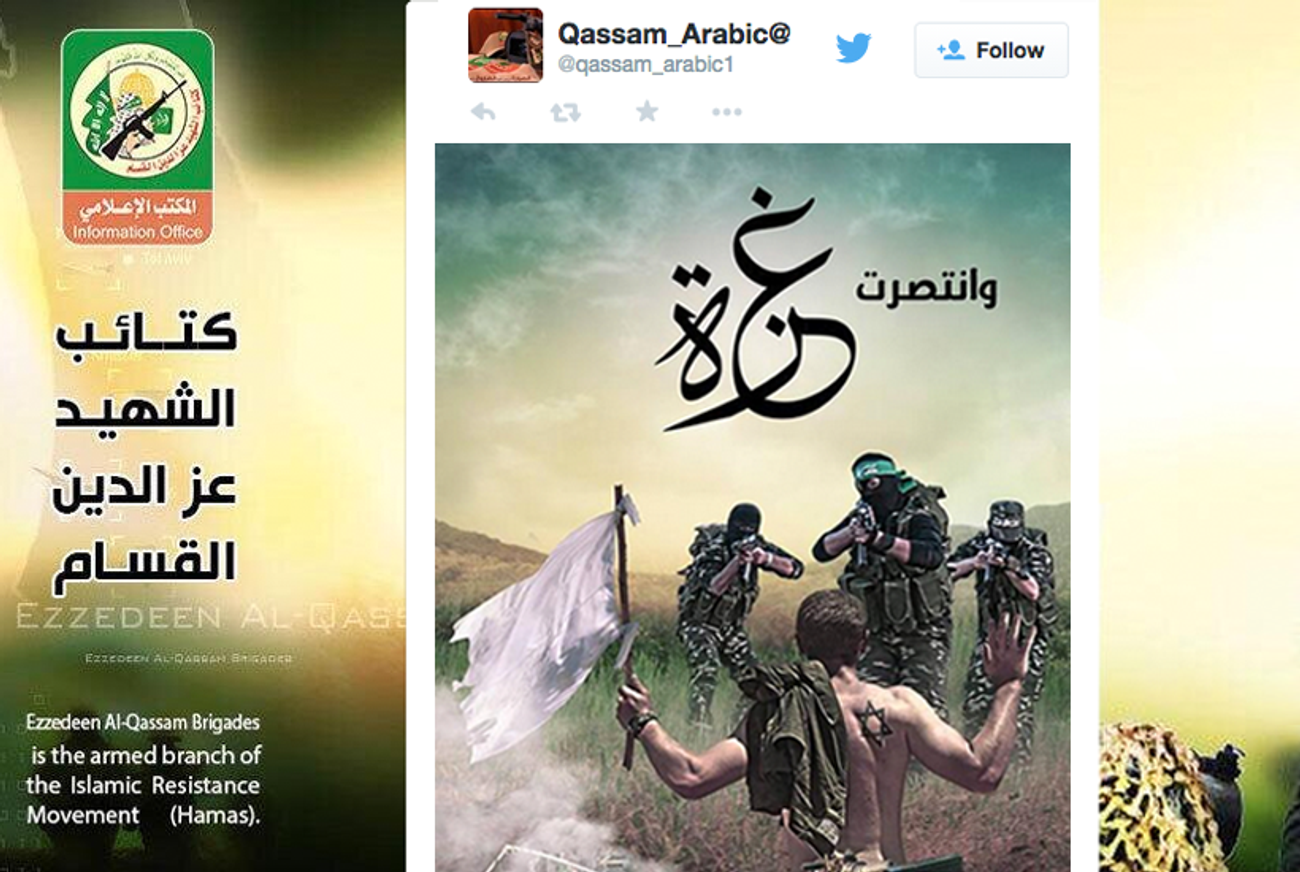A Tale of Three Twitter Feeds: Hamas Tweets in Arabic, English, and Hebrew
Analysis of the social-media messaging of Hamas’ military wing reveals distinct voices for the West, the Arab Middle East, and Israel




During the late afternoon on Aug. 26, hours before the Egyptian-mediated ceasefire in Gaza began, Hamas’ military wing—Al-Qassam Brigades—launched its final attacks on Israel. In addition to the dozens of rockets shot by Al-Qassam Brigades, @qassam_Arabic1, Al-Qassam’s official Arabic Twitter account, defiantly posted dozens of tweets declaring unconditional triumph. Sprinkling religious messaging on their Arabic Twitter page, Al-Qassam frequently utilized Quranic language to inspire its followers. At the same time, in English, Al-Qassam was posting online messages employing terms such as “human rights” to attract a Western audience while emphasizing Palestinian suffering—a campaign that has arguably captured more tangible benefits and strategic ground for the Islamist group than its missiles and tunnels did during the actual fighting this summer.
With 91,400 followers and counting, al-Qassam’s Arabic Twitter page has built a substantial network. Mukhaimer Abu Saada, a professor of political science at Gaza’s Al-Azhar University, explained that Palestinians “felt that the Arab media was not paying enough attention to what was happening in Gaza because the Arab press was busy covering Syria, Iraq, and Libya.” The Al-Qassam media team stepped into that gap, frequently posting over 30 tweets daily during the war, including videos of attacks and pictures of fighters. Some tweets were mainly informative. For example, “#Breaking 22:30 Al-Qassam Brigades has shelled the occupied Ashdod with 3 Grad Rockets.” Others are far more aggressive, with Al-Qassam posting a picture of a burning car in Beer Sheva, claiming that it had been hit by a Palestinian rocket and boasting that the “enemy knows of injured violators” after the rocket strike. Al-Qassam also used the same word, violator, when announcing the death of 4-year-old Israeli Daniel Tragerman, who was killed by Hamas mortar fire.
One of Al-Qassam’s most popular broadcasted clips was the video showing how its fighters infiltrated a military base inside Israel via an underground tunnel, killing five ill-prepared Israeli soldiers at close range. When Al-Qassam linked the YouTube video to its Twitter account, the post was retweeted 1,476 times and the clip spread to Arab and Israeli TV channels, increasing its popularity. By emphasizing its killing of dozens of Israeli soldiers, Al-Qassam was, according to Abu Saada, “trying to boost the morale of the Palestinians that in spite of all of this killing, damage, and destruction, Al-Qassam Brigades was doing well confronting the Israeli Army.” Since Gazans were experiencing such devastating Israeli attacks, Al-Qassam needed to show its people that they were not dying in vain.
After Al-Qassam masked spokesman Abu Ubedia threatened over Hamas’ Al Aqsa TV to strike Tel Aviv during the beginning of the conflict, many Gazans were thrilled by the taunts. (“When we heard the threat last night, we were overjoyed. It’s excellent,” a 19-year-old Gazan named Mohammed Abu Asi explained to Reuters.) According to an August public-opinion poll conducted by the Palestinian Center for Policy and Survey Research, Hamas’ TV channel obtained higher viewership than other Arabic-language stations, including Al Jazeera, Al Arabiya, and Palestine TV—with many Gazans reportedly relying solely on Al Aqsa. But in many of the cases of reported news delivered via Twitter, Hamas media neglects to mention that Israel’s Iron Dome defense system intercepted many of the Hamas rockets that viewers saw on their TV screens.
After Israel’s acceptance of an Egyptian ceasefire proposal, Al-Qassam stressed complete victory. In a startling illustration, Al-Qassam photo-shopped one of its fighters aiming his weapon at a half-dressed Israeli soldier who was shown holding a white flag and surrendering, with the slogan “Gaza was victorious” plastered prominently on the image. Reactions to Hamas’ victory messages appear to have been mixed. On the one hand, a majority of Palestinians in the West Bank and Gaza believe that Hamas won the war, according to a Palestinian public-opinion poll taken immediately following the operation. On the other hand, Gazans could not ignore the overwhelming devastation caused by this same war. Subsequent foreign pledges of $5.4 billion to rebuild Gaza may also add credence to Hamas’ narrative by erasing the physical damage while showing tangible results for the struggle.
While using many of the same pictures and quotes in both its English and Arabic online portals, Al-Qassam changes the tone of some of its messages to better fit a Western audience. In the majority of its English descriptions of specific attacks, Al-Qassam stresses that it was targeting military sites. For instance, 14 out of the 15 rocket attacks listed on Aug. 25 on Al-Qassam’s English website were military targets, including a 12:35 attack at the “military base in Hulet.” However, when Al-Qassam tweeted about the same exact incident in Arabic, the social-media team omitted any mention of a military base and merely stated that Al-Qassam targeted Kibbutz Hulet. Twitter has repeatedly suspended Al-Qassam’s English Twitter site with Al-Qassam often changing its name and quickly reappearing. When Twitter blocked @qassambrigade in January 2014, for example, Al-Qassam’s website protested the move, claiming “Twitter seems subordinated to the American pro-Israeli organizations supporting terror against Palestinian people.”
The differences in tone between the messaging used by Hamas for different groups of social media and Internet users is hard to miss. Al-Qassam’s English-language website, for example, features an entire section devoted to “human rights.” In contrast, on the Arabic website, there is no section devoted to human rights. Instead, Al-Qassam’s Arabic media staff inserted a tab labeled “battles and operations,” which details Al-Qassam’s military missions against Israel.
The deliberate nature of the disparities between Al-Qassam’s Arabic militant posts and Hamas’ political messages was made particularly clear in a video produced by Hamas’ Ministry of Interior. In the video, social-media activists are instructed that one should “always” describe “all” Gazans who were killed as “innocent civilians,” even if they were Hamas fighters. In contrast to the many arms-carrying militants portrayed on Al-Qassam’s Arabic Twitter feed, Hamas’ Ministry of Interior warns users not to spread videos or pictures of Hamas fighters or rocket-launching sites. Finally, the clip encourages individuals to “focus” on “the number of women and children martyrs” and urges them to share pictures of those who were injured.
The same careful attention to messaging shaped the statements of Hamas’ leaders. When Hamas political leader Khaled Meshal was interviewed by Western media outlets, as happened repeatedly throughout and after the war, he shifted Hamas’ messaging away from Hamas’ more combative Arabic tweets toward the kind of language that Western audiences would receive as more moderate and reasonable. On BBC, Meshal twice mentioned that “our Palestinian people have a right to their own state in the West Bank and Gaza”—as though Hamas was fighting for a Palestinian state within the 1967 borders. Yet, Hamas TV consistently called all Israelis, including those who lived in pre-1967 Israel, “settlers,” in consonance with the organization’s charter and repeated public declarations laying claim to “all of Palestine.” In a separate interview with PBS’ Charlie Rose, Meshal stated that “we do not fight the Jews because they are Jews per se. We fight the occupiers. I’m ready to coexist with the Jews”—again suggesting, to Western listeners who were willing or eager to hear him talk that way, a potential willingness to recognize an Israeli state within the 1967 lines. At the same time in Arabic, Al-Qassam was celebrating the death of a 4-year-old Israeli “settler” from Nahal Oz, who lived far away from any West Bank settlement.
Hamas ensured that its dual messaging system was preserved by its attitudes toward foreign journalists who did not tow the regime’s line. As reported in GlobalPost, in an interview with the Lebanese Al Mayadeen television, Hamas spokeswoman Isra al-Modallal emphasized, “some of the journalists who entered the Gaza Strip were under security surveillance.” If these journalists were “fixated on the Israeli narrative” by insisting on covering Palestinian rockets, “these journalists were deported from the Gaza Strip. The security agencies would go and have a chat with these people. They would give them some time to change their message, one way or the other,” she explained. Al-Modallal’s comments were confirmed by the Foreign Press Association in Israel and Palestine’s Aug. 15 statement “protesting in the strongest terms the blatant, incessant, forceful and unorthodox methods employed by the Hamas authorities and their representatives against visiting international journalists” in Gaza.
Nonetheless, Al-Qassam still found it necessary to justify in English Hamas’ public execution of 18 Palestinian collaborators, in an article on its homepage titled “Palestinian traitors working for Nazi-Israel deserve death.” Nathan Brown, a professor of political science at George Washington University and an expert on Palestinian politics, emphasized in an interview the dissonance in how external and internal audiences interpret these actions. “In Western circles, people were struck by this extrajudicial execution that looks extremely brutal,” he said. “But internally those killed were traitors or collaborators and swift justice is what is necessary.”
While Al-Qassam’s English messaging was designed to show Hamas as the moral underdogs, the organization’s Hebrew social media team focused primarily on intimidating the Israeli public. One Tweet included an Al-Qassam fighter inside a tunnel aiming a rifle at the viewer with “see you later!” written in Hebrew. Another Tweet included the popular resistance quote translated into Hebrew, “With Blood and fire, we will redeem Palestine.” Yet although the Al-Qassam social-media team invested considerably in its Hebrew Twitter account—in contrast to its Arabic feed—Al-Qassam struggled to attract an Israeli audience. Written entirely in Hebrew, Al-Qassam frequently updated its feed and inserted videos, images, and info-graphics. Yet, only approximately 840 individuals followed Al-Qassam’s Hebrew feed by the end of the war, with some posts not even retweeted once.
Orit Perlov, an Israeli expert in Arab social media and a research fellow at the Institute for National Security Studies, said that Al-Qassam failed to achieve its goals of terrorizing the Israeli public through its social-media operations. “The only ones who read it were the correspondents and journalists. For them it was more of an amusement and a sexy thing to talk about.” While one could argue that Israeli attitudes toward Hamas demonstrate arrogance, this ignores the Israeli attitude toward Hezbollah. After years of Hassan Nasrallah organizing successful military operations that killed hundreds of Israeli soldiers and civilians, many Israelis genuinely fear and even show a begrudging professional respect toward Hezbollah, with Nasrallah’s messages often causing panic. One of the few Al-Qassam tweets that grabbed Israeli attention and was retweeted 17 times was its threat, “We are further clarifying that we will not sign any agreement that doesn’t include establishing a sea-port in Gaza.” Yet, this post only spread across Israeli social media nine days later, after Hamas agreed to a ceasefire that did not include a seaport. Influential Israeli journalists, including Haaretz’s Barak Ravid, retweeted Al-Qassam’s intended hostile message in a mocking fashion as Al-Qassam’s threats appeared groundless.
In Western media, Al-Qassam’s aggressive messaging of its military achievements and heroic barrages of rockets struggled to penetrate the dominant narrative of wanton Israeli destruction and killings in Gaza. While Al-Qassam’s Arabic Twitter page endlessly broadcast videos of masked Hamas fighters holding Israeli weapons or armed to the teeth inside tunnels, the Western media—for whatever reason—barely covered this issue.
***
Like this article? Sign up for our Daily Digest to get Tablet Magazine’s new content in your inbox each morning.
Aaron Magid, a Harvard University graduate student specializing in Middle Eastern Studies, has written for The New Republic, Al-Monitor and Lebanon’s Daily Star. His Twitter feed is @AaronMagid.
Aaron Magid, a Harvard University graduate student specializing in Middle Eastern Studies, has written for The New Republic, Al-Monitor and Lebanon’s Daily Star. His Twitter feed is @AaronMagid.